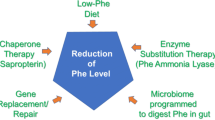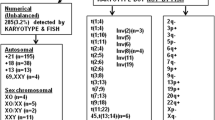Abstract
Physiologic concentration in amniotic fluid (AF) of several metabolites has not been established with certainty. In this study, we initially assayed purines, pyrimidines, and amino compounds in 1,257 AF withdrawn between the 15th and the 20th week of gestation from actually normal pregnancies (normal gestations, normal offspring). Results allowed to determine physiologic reference intervals for 45 compounds. In these AF, not all purines and pyrimidines were detectable and uric acid (238.35 ± 76.31 μmol/l) had the highest concentration. All amino compounds were measurable, with alanine having the highest concentration (401.10 ± 88.47 μmol/l). In the second part of the study, we performed a blind metabolic screening of AF to evaluate the utility of this biochemical analysis as an additional test in amniocenteses. In 1,295 additional AF from normal pregnancies, all metabolites fell within the confidence intervals determined in the first part of the study. In 24 additional AF from women carrying Down’s syndrome-affected fetuses, glutamate, glutamine, glycine, taurine, valine, isoleucine, leucine, ornithine, and lysine were different from physiologic reference values. One AF sample showed phenylalanine level of 375.54 μmol/l (mean value in normal AF = 65.07 μmol/l) and was from a woman with unreported phenylketonuria with mild hyperphenylalaninemia (serum phenylalanine = 360.88 μmol/l), carrying the IVS 4 + 5 G-T and D394A mutations. The fetus was heterozygote for the maternal D394A mutation. An appropriate diet maintained the mother phenylalanine in the range of normality during pregnancy, avoiding serious damage in fetal and neonatal development. These results suggest that the metabolic screening of AF might be considered as an additional biochemical test in amniocenteses useful to highlight anomalies potentially related to IEM.



Similar content being viewed by others
Abbreviations
- Ala:
-
Alanine
- AAAA:
-
α-aminoadipic acid
- AF:
-
Amniotic fluid
- Arg:
-
Arginine
- Arg-succ:
-
Argininosuccinate
- Asn:
-
Asparagine
- Asp:
-
Aspartate
- Carn:
-
Carnosine
- CI:
-
Confidence interval
- Cit:
-
Citrulline
- CV:
-
Coefficient of variation
- Cystat:
-
l-Cystathionine
- GABA:
-
γ-Aminobutyrate
- Gln:
-
Glutamine
- Glu:
-
Glutamate
- Gly:
-
Glycine
- HPLC:
-
High-performance liquid chromatography
- His:
-
Histidine
- IEM:
-
Inborn errors of metabolism
- Ile:
-
Isoleucine
- ISTD:
-
Internal standard
- Leu:
-
Leucine
- LOD:
-
Lowest limit of detection
- LOQ:
-
Lowest limit of quantification
- Lys:
-
Lysine
- MA:
-
Malonic acid
- Met:
-
Methionine
- MHPA:
-
Mild hyperphenylalaninemia
- MMA:
-
Methylmalonic acid
- MPA:
-
3-Mercaptopropionic acid
- NAA:
-
N-acetylaspartate
- Norval:
-
Norvaline
- OPA:
-
Ortophtalaldehyde
- Orn:
-
Ornithine
- PAH:
-
Phenylalanine hydroxylase
- Phe:
-
Phenylalanine
- PKU:
-
Phenylketonuria
- SAH:
-
S-adenosylhomocysteine
- SAM:
-
S-adenosylmethionine
- Ser:
-
Serine
- Tau:
-
Taurine
- Thr:
-
Threonine
- Trp:
-
Tryptophane
- Tyr:
-
Tyrosine
- Val:
-
Valine
References
Jones PM, Bennett MJ (2010) Urine organic acid analysis for inherited metabolic disease using gas chromatography-mass spectrometry. Methods Mol Biol 603:423–431
Pitt JJ, Eggington M, Kahler SG (2002) Comprehensive screening of urine samples for inborn errors of metabolism by electrospray tandem mass spectrometry. Clin Chem 48:1970–1980
Simoni RE, Gomes LN, Scalco FB, Oliveira CP, Aquino Neto FR, de Oliveira M (2007) Uric acid changes in urine and plasma: an effective tool in screening for purine inborn errors of metabolism and other pathological conditions. J Inherit Metab Dis 3:295–309
Geelhoed EA, Lewis B, Hounsome D, O’leary P (2005) Economic evaluation of neonatal screening for phenylketonuria and congenital hypothyroidism. J Paediatr Child Health 41:575–579
Gao T, Zablith NR, Burns DH, Skinner CD, Koski KG (2008) Second trimester amniotic fluid transferrin and uric acid predict infant birth outcomes. Prenat Diagn 28:810–814
Gao T, Zablith N, Burns DH, Koski KG, Skinner CD (2009) Identification and quantitation of human amniotic fluid components using capillary zone electrophoresis. Anal Biochem 388:155–157
Inoue Y, Ohse M, Shinka T, Kuhara T (2008) Prenatal diagnosis of propionic acidemia by measuring methylcitric acid in dried amniotic fluid on filter paper using GC/MS. J Chromatogr B 870:160–163
López Ramón Y, Cajal C, Ocampo Martínez R, Couceiro Naveira E, Martínez M (2007) Amino acids in amniotic fluid in the 15th–16th weeks of gestation and preterm labor. J Matern Fetal Neonatal Med 20:225–231
Oliveira FR, Barros EG, Magalhães JA (2002) Biochemical profile of amniotic fluid for the assessment of fetal and renal development. Braz J Med Biol Res 35:215–222
Cohn BR, Joe BN, Zhao S, Kornak J, Zhang VY, Iman R, Kurhanewicz J, Vahidi K, Yu J, Caughey AB, Swanson MG (2009) Quantitative metabolic profiles of 2nd and 3rd trimester human amniotic fluid using (1)H HR-MAS spectroscopy. MAGMA 22:343–352
Graça G, Duarte IF, Goodfellow BJ, Carreira IM, Couceiro AB, Domingues Mdo R, Spraul M, Tseng LH, Gil AM (2008) Metabolite profiling of human amniotic fluid by hyphenated nuclear magnetic resonance spectroscopy. Anal Chem 80:6085–6092
Graça G, Duarte IF, Barros AS, Goodfellow BJ, Diaz S, Carreira IM, Couceiro AB, Galhano E, Gil AM (2009) (1)H NMR based metabonomics of human amniotic fluid for the metabolic characterization of fetus malformations. J Proteome Res 8:4144–4150
Ottolenghi C, Abermil N, Lescoat A, Aupetit J, Beaugendre O, Morichon-Delvallez N, Ricquier D, Chadefaux-Vekemans B, Rabier D (2010) Gestational age-related reference values for amniotic fluid organic acids. Prenat Diagn 30:43–48
Tavazzi B, Lazzarino G, Leone P, Amorini AM, Bellia F, Janson CG, Di Pietro V, Ceccarelli L, Donzelli S, Francis JS, Giardina B (2005) Simultaneous high performance liquid chromatographic separation of purines, pyrimidines, N-acetylated amino acids, and dicarboxylic acids for the chemical diagnosis of inborn errors of metabolism. Clin Biochem 38:997–1008
Friedecky D, Adam T, Bartak P (2002) Capillary electrophoresis for detection of inherited disorders of purine and pyrimidine metabolism: a selective approach. Electrophoresis 23:565–571
Vidotto C, Fousert D, Akkermann M, Griesmacher A, Müller MM (2003) Purine and pyrimidine metabolites in children’s urine. Clin Chim Acta 335:27–32
Waterval WA, Scheijen JL, Ortmans-Ploemen MM, Habets-van der Poel CD, Bierau J (2009) Quantitative UPLC-MS/MS analysis of underivatised amino acids in body fluids is a reliable tool for the diagnosis and follow-up of patients with inborn errors of metabolism. Clin Chim Acta 407:35–42
Monsen AL, Schneede J, Ueland PM (2006) Mid-trimester amniotic fluid methionine concentrations: a predictor of birth weight and length. Metabolism 55:1186–1191
Amaral C, Gallardo E, Rodrigues R, Pinto Leite R, Quelhas D, Tomaz C, Cardoso ML (2010) Quantitative analysis of five sterols in amniotic fluid by GC-MS: application to the diagnosis of cholesterol biosynthesis defects. J Chromatogr B 878:2130–2136
Bouchlariotou S, Tsikouras P, Maroulis G (2009) Undiagnosed maternal phenylketonuria: own clinical experience and literature review. J Matern Fetal Neonatal Med 22:943–948
Brass CA, Isaacs CE, McChesney R, Greengard O (1982) The effects of hyperphenylalaninemia on fetal development: a new animal model of maternal phenylketonuria. Pediatr Res 16:388–394
Rouse B, Azen C (2004) Effect of high maternal blood phenylalanine on offspring congenital anomalies and developmental outcome at ages 4 and 6 years: the importance of strict dietary control preconception and throughout pregnancy. J Pediatr 144:235–239
Fekkes D, van Dalen A, Edelman M, Voskuilen A (1995) Validation of the determination of amino acids in plasma by high-performance liquid chromatography using automated pre-column derivatization with o-phthaldialdehyde. J Chromatogr B 669:177–186
Hilton MA (1982) Liquid-chromatographic direct determination of phenylalanine and tyrosine in serum or plasma, with application to patients with phenylketonuria. Clin Chem 28:1215–1218
Zhang LF, Yu YL, Yang RY (1983) Direct determination of phenylalanine in serum extracts of phenylketonuria patients by reversed-phase high-performance liquid chromatography. J Chromatogr 282:333–339
Graca G, Duarte IF, Barros AS, Goodfellow BJ, Diaz SO, Pinto J, Carreira IM, Galhano E, Pita C, Gil AM (2010) The impact of prenatal disorders on the metabolic profile of 2nd trimester amniotic fluid: a nuclear magnetic resonance (NMR) metabonomic study. J Proteome Res 9:6016–6024
Acknowledgments
This study was supported in part by research funds of the University of Catania. A special thank to Dr. Roberto Tozzi for his significant contribution in the statistical analysis of data.
Author information
Authors and Affiliations
Corresponding author
Rights and permissions
About this article
Cite this article
Amorini, A.M., Giorlandino, C., Longo, S. et al. Metabolic profile of amniotic fluid as a biochemical tool to screen for inborn errors of metabolism and fetal anomalies. Mol Cell Biochem 359, 205–216 (2012). https://doi.org/10.1007/s11010-011-1015-y
Received:
Accepted:
Published:
Issue Date:
DOI: https://doi.org/10.1007/s11010-011-1015-y




